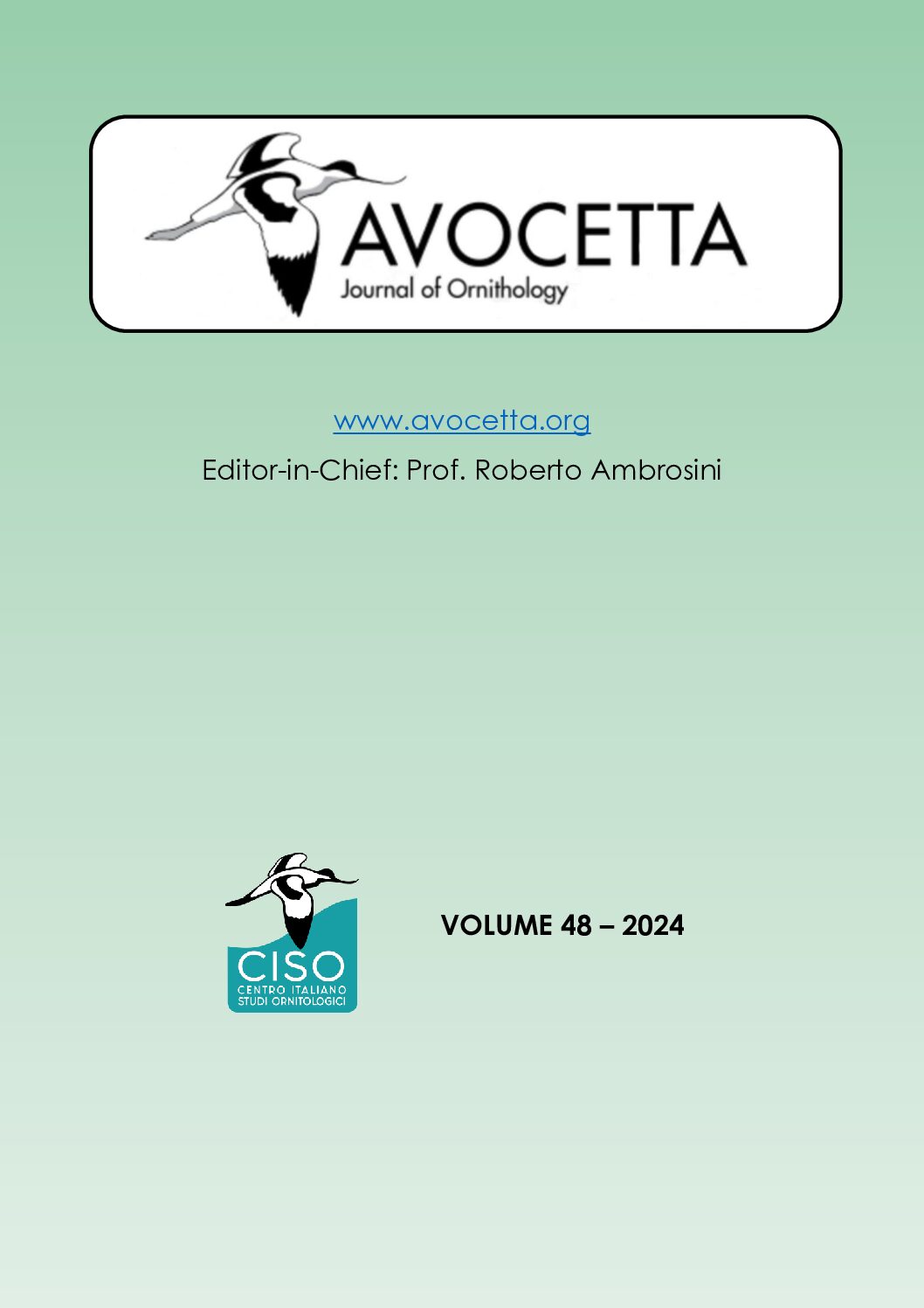
Volume 48
2024
Layout by Roberto Brembilla
Avocetta
Volume 48 continuous publishing
-
Editorial - The pitfalls and potential of citizen
science in ornithology
Arianna Passarotto & Alessandra Costanzo
-
The humble Stonechat Saxicola rubicola and the species neglected by ornithological research in Italy
Maurizio Sarà
-
Territory selection of breeding Golden Eagles Aquila chrysaetos in a low-density population
Andrea Mazzarano, Riccardo Mattea, Gianluca Damiani
-
Diet of Golden Eagle (Aquila chrysaethos) nestlings in Central Apennines, Italy
Gianluca Damiani, Andrea Mazzarano, Silvia Dancali, Paolo Forconi
-
Moult strategies and morphometric precisions in the Lilford's woodpecker Dendrocopos leucotos lilfordi
Patrice Urbina-Tobias, Jean-Louis Grangé
-
Occurrence of Laminosioptes cysticola (Acariformes: Laminosioptidae) in Ardea alba egretta from the peri-urban area of Belém, Pará-Brazil
David F. Conga, Gerson B. Oliveira, Amanda A. Figueiredo, Ana Sílvia S. Ribeiro, Washington L.A. Pereira
-
The State of Sombre Tit Poecile lugubris Temminck, 1820 in Armenia
Karen Aghababyan, Gurgen Khanamirian, Viktorya Gevorgyan, Asya Ghazaryan
-
Laying eggs on the same nest: unusual mixed-species clutch among three colonial shorebirds
Paolo Salvador, Stefano Sponza
-
Long-term population trends of bird communities in artificially-protected wetlands of Northern Italy
Stefano Borghi, Carlo Giannella, Andrea Ravagnani, Rossella Casari, Alessio Farioli, Giuseppe Rossi, Matteo Dal Zotto, Nunzio Grattini, Daniela Campobello
-
New extra-Amazonian records of the Black-billed Cuckoo Coccyzus erythropthalmus (Cuculidae) for Brazil
Fabio Schunck, Luis Katsumi Yabase, Marta Yabase, Guilherme Alves Serpa, Mateus Rocha Ribas, Pedro Scherer-Neto, Gérard Baudet, Eduardo Carrano, Tomas Sigrist, Guilherme Renzo Rocha Brito
-
To change not to drown: Eurasian Oystercatchers Haematopus ostralegus adopt pole tops as safe nesting sites in the Lagoon of Venice
Roberto G. Valle, Francesco Scarton
-
The Golden Eagle Aquila chrysaetos in the northern Marches Apennines (Central Italy). Long-term monitoring (1983-2023) in the mountains of Pesaro-Urbino
Maurizio Saltarelli, Marco Pantalone
-
Forum - Conservation experiences, evidence, and opinions: Conservation front lines need experienced troops: the role of a scientific trust in a changing world
Corrado Battisti, Roberto Ambrosini, Giacomo Assandri, Rosario Balestrieri, Enrico Bassi, Gaia Bazzi, Alessandro Berlusconi, Chiara Bettega, Giuseppe Bogliani, Letizia Campioni, Benedetta Catitti, Gianpasquale Chiatante, Alessandra Costanzo, Davide Dominoni, Giulia Masoero, Alessandro Montemaggiori, Flavio Monti, Michelangelo Morganti, Arianna Passarotto, Samuele Ramellini, Gloria Ramello, Maurizio Sarà
-
Population size and breeding success of the Scopoli’s Shearwater on
Lampione Islet
Antonella Di Gangi, Vittoria Roatti, Federico Ottoveggio, Bruno Massa & Giacomo Dell'Omo
-
Nesting tree
selection in urban Woodpigeon; applications in urban planning to reduce the
conflicts with human activities
Eduardo Gil, Anika Meyer, Diego Villanúa
-
Preliminary data on the activity of male and female common pheasants Phasianus colchicus during the breeding period in a Mediterranean area
Andrea Viviano, Lorenzo Lazzeri, Alessandro Vitale, Emiliano Mori
-
Vocal and territorial behaviour of Puff-throated Babbler, a South-Asian duetting passerine
Ekaterina M. Shishkina, Nguyen Van Linh, Alexey S. Opaev
-
First deployment of IoT tracking devices on Common swift Apus apus: a pilot study
Michelangelo Morganti, Milo Manica, Daniela Casola, Lorenzo Colombo, Alessandra Stocchetti, Wolfgang Fiedler, Martin Wikelski, Klaudia Witte, Timm Wild4

